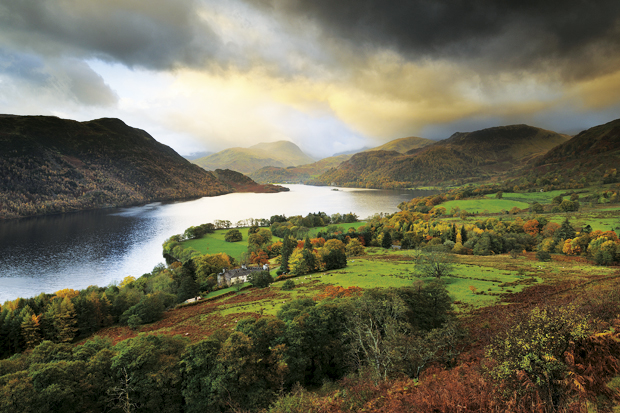I couldn’t decide on starting England’s 100 Best Views whether it was a batty idea for a book or a perfectly sensible one. Why write about something that begs to be seen? Would this not be better as a collection of photographs, with helpful accompanying maps and perhaps a checklist that, once filled in, entitled you to a badge from Big Chief I-Spy?
On the other hand, as Jenkins (he’s Sir Simon, of course, but book reviews know no distinctions of rank) explains in his introduction, a view is more than just a picture: it is something mobile — a collocation of geography and geology, the built environment and the weather, the movements of birds and mammals, and the mood of the person taking it in. It combines things that change in cycles of seconds with things that have changed over hundreds of millions of years.
You need, in other words, not only someone to tell you where to look, but someone to explain what you are looking at. Our author — as well as being briskly opinionated — is more than up to the task. He sees all these time scales clearly: from the Tyndale monument (commenced 1863) he looks upstream to a power station opened in 1967 and a castle started in 1067. Also, it’s clear that he has really walked around these views and thought about them, often preferring a slightly off-canon position. If he has a bias it’s to favour a lower elevation, enjoying that sense of inhabiting the contours of a landscape rather than looking down on it as on a map.
He skips nimbly from social history to geology, from town-planning to ecology. And he almost always has a literary quotation in his back pocket, though you might think that dividing up the ‘sceptred isle’ speech from Richard II and dropping dollops on pages 118 and 134 is a bit niggardly. One moment he’ll be discussing Constable, the next mentioning a 1970s Hovis ad and admitting to having seen a bawdy YouTube parody.
His section on Derbyshire’s Kinder Scout, the moorland plateau in the Dark Peak, affords him the chance to digress (via the famous 1932 ‘mass trespass’) into a capsule history of right-to-roam legislation. The effects of the tin, wool and iron industries on the landscape are deftly dealt with where they cross his line of vision. Who knew, for instance, that Hebden Bridge used to be known as ‘trouser town’? You’ll encounter all sorts of things under his tutelage; I come away from his 100 Views with a pipeful of ‘pargeting’, ‘reef knolls’, ‘shake holes’, ‘throughs’ and ‘solifluction’ to smoke at my leisure.
The section on Plymouth Sound is typical of Jenkins’s range. In a few hundred words he’s briskly summarised its war and postwar history (‘What the Luftwaffe left standing, Plymouth’s city fathers set about destroying’), dropped in apt short quotations from Thomas Hardy and Geoffrey Grigson, dispatched an old canard about Sir Francis Drake, name-checked the Pilgrim Fathers, told you about Mount Edgcumbe’s peculiar history, zinged back to a pre-historic settlement that may have traded with Iberia and the Mediterranean, located the site of the annual British Fireworks Championships, told a story about Nancy Astor dancing with sailors and warned that you can’t climb Smeaton’s Tower after 4.30 p.m. or on Sundays. Not only that, but he knows that in 2008 the council put forward a proposal to get rid of buildings of ‘negative quality’, and that nothing has so far come of it. Plymouth be warned, Jenkins has his eye on you.
What he doesn’t have — and doesn’t aspire to — are the lyrical gifts of the likes of Robert Macfarlane, whose books might well do without photographs altogether. He seldom ventures on a simile but when he does it becomes a bit repetitive: Selworthy Beacon is like ‘a one-eyed whale’, the East Lyn river is ‘like the tentacles of a green octopus’, while ‘the adjacent Stiperstones can be likened to a shark, restlessly patrolling the Welsh border; the Long Mynd is a beached whale’.
Rather, his virtues are the well-turned, pragmatic English sentence in the plain style: decisive, unsentimental, well-informed, smart. He jumps drily from place to place and subject to subject. But nor is he without soul. ‘The landward bank of Chesil Beach is rich in sea kale, sea pea, yellow horned poppy, campion and eel grass,’ he writes at one point, adding with odd poignancy, ‘I am told it is home to the rare scaly cricket, which does not fly, sing or hop — a bleak existence.’
Of course his conclusions are subjective. That said, I turned the book over for a sniff-test to my father-in-law, an extremely well-travelled distance walker and countryman who knows the north-east especially well. He grumbled slightly that Dunstanburgh Castle didn’t get more than a passing mention, but found it hard to take exception to any of Jenkins’s choices, and indeed was some time later still to be found murmuring approvingly, snout-deep in the Cheviots.
Most of these views are rural or semi-rural, though we do get the Royal Crescent in Bath, Newcastle’s beautifully proportioned Grey Street, and a handful in London. By and large Jenkins — as befits the chairman of the National Trust and a veteran of English Heritage’s historic areas committee — favours the timeworn. He detests the Shard and the Walkie Talkie, and cordially loathes the giant white wind turbines that seem apt at any moment to despoil long views over our countryside. The book’s heroes include Capability Brown, Humphrey Repton and Gertrude Jekyll; its villains are such as ‘the communist architect Graeme Shankland’ and ‘the local government regime of T. Dan Smith’, which razed ‘two sides of stately Eldon Square’ in Newcastle.
But Jenkins is certainly not a reactionary. He’s aware that, as he puts it, ‘conservation is a strangely biased ideology.’ Some of what he writes in a thoughtful epilogue suggests that there could be a long, more reflective essay to come on the meaning of the picturesque, the ideology of conservation and the tricky question of how you build the aesthetic quality of the environment into planning legislation. On the strength of this, I look forward to it.
Got something to add? Join the discussion and comment below.
Get 10 issues for just $10
Subscribe to The Spectator Australia today for the next 10 magazine issues, plus full online access, for just $10.
You might disagree with half of it, but you’ll enjoy reading all of it. Try your first month for free, then just $2 a week for the remainder of your first year.















Comments
Don't miss out
Join the conversation with other Spectator Australia readers. Subscribe to leave a comment.
SUBSCRIBEAlready a subscriber? Log in